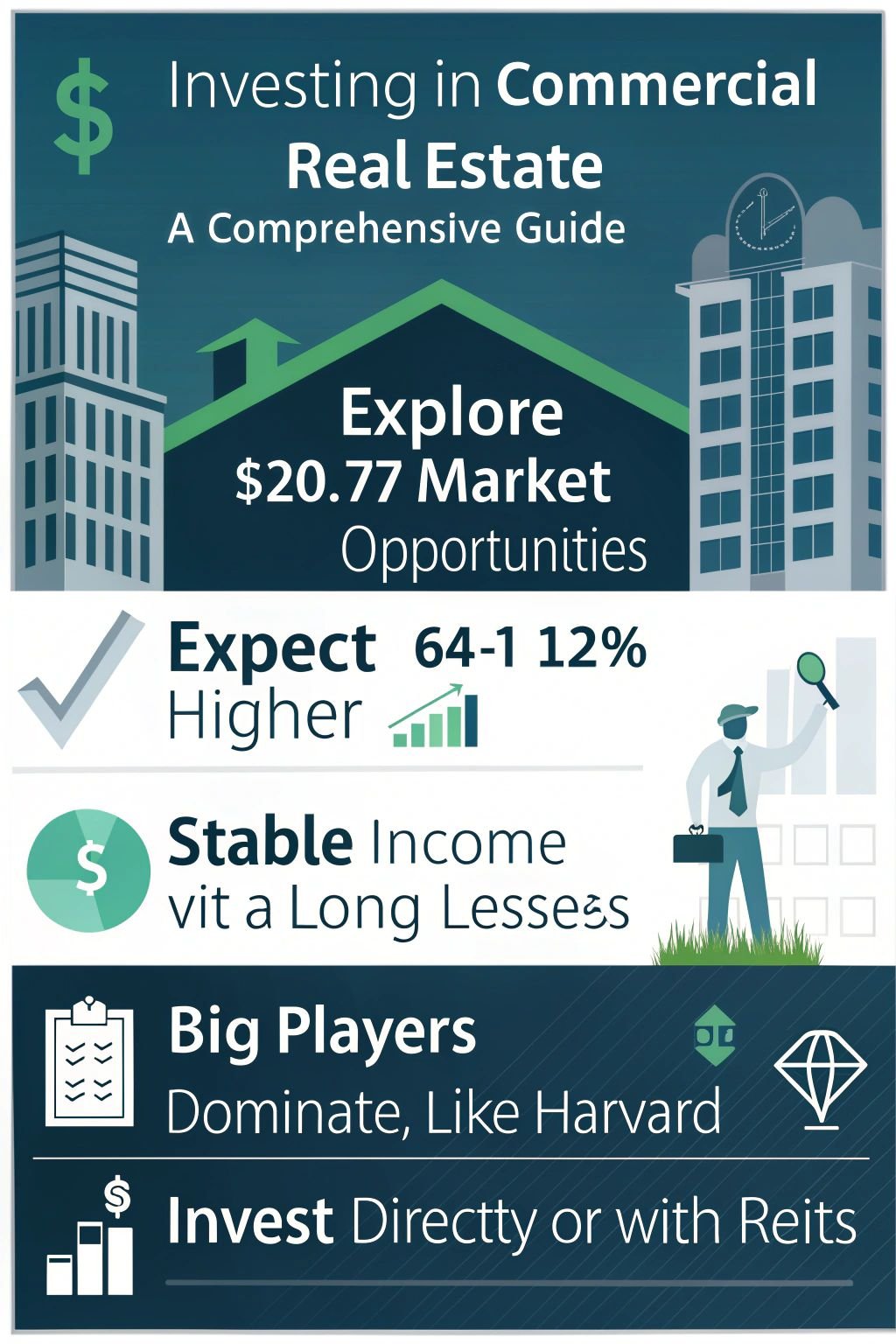Are you a homeowner looking to grow your money but don’t know where to start? Many people want to invest but feel unsure about the best way.
Commercial real estate investments include office spaces, retail properties, industrial sites, and multi-family complexes. 2 This guide will help you learn the basics, set your goals, secure funding, and choose the right properties. 1 Keep reading to discover how you can succeed in commercial real estate investments. 3
Key Takeaways
- Wide Range of Properties: Commercial real estate includes offices, retail stores, warehouses, and multi-family apartments. The market is valued at $20.7 trillion.
- Higher Returns: Investors can expect a return on investment between 6% and 12%, which is higher than single-family homes.
- Stable Income: Long-term leases (3 to 25 years) provide steady cash flow and reduce tenant turnover, ensuring reliable income.
- Big Market Players: Companies like Harvard Management Company manage over $50 billion in real estate, showing many opportunities available.
- Diverse Investment Options: You can invest directly by buying properties or indirectly through REITs and syndications to diversify your portfolio.

What is Commercial Real Estate Investing?

Commercial real estate investing means you’re putting your money into buildings businesses use. Think office spaces, stores, warehouses, or apartment complexes. You earn money through rent, ads, or when the property’s value goes up.
On average, you can expect a return on investment between 6% and 12%. That’s a lot more than what single-family homes usually offer. The commercial real estate market is huge—worth about $20.7 trillion! 1
Investing in commercial properties can turn your money into a steady stream of income.
Harvard Management Company, for example, handles over $50 billion in real estate. With such big players in the game, you know there are plenty of opportunities. Ready to explore the different types of commercial properties?
Types of Commercial Real Estate

Commercial real estate isn’t one-size-fits-all. Let’s see how different property types can work for your investment goals.
Office Spaces
Office spaces range from small buildings to large corporate headquarters. You can choose low-rise, mid-rise, or high-rise properties. 2 Locations vary too—some are in the central business district (CBD), while others are in suburban areas. 2 These spaces are leased for administrative and professional use, offering longer lease terms of three to ten years. Longer leases mean more stable rental income and lower tenant turnover, boosting your net operating income (NOI).
Demand for office spaces depends on the quality of your tenants and the lease terms you offer. High-quality tenants with good credit are more likely to commit to longer leases, providing you with reliable cash flow.
Office properties can be general, medical, or flex spaces, allowing different types of businesses to share the same area. This variety helps you diversify your investment portfolio and attract a wide range of tenants.
Next, explore how retail properties are adapting to new consumer behaviors.
Retail Properties
Shifting from office spaces, retail properties offer exciting opportunities. These include grocery stores and clothing shops, often grouped for easy shopping. 3 Retail properties vary from single-tenant buildings to big shopping centers.
In Q3 2024, e-commerce made up 16.2% of total retail sales. Urban trends now favor smaller spaces that create unique, personalized experiences. Retailers must update their physical stores to match their online presence and meet what customers want today.
Investing in retail real estate can boost your portfolio with steady cash flow and potential property value increases.
Industrial Real Estate
Industrial real estate plays a vital role in the commercial property market. It includes spaces for manufacturing, warehousing, and distribution. Companies like Amazon, UPS, and FedEx are common tenants.
The rise of e-commerce has boosted the demand for these properties. There are three main types: manufacturing, warehouse, and flex/R&D spaces. 4 Most warehouses focus on storage and distribution, with less than 15% used for offices.
Investing in industrial properties can provide strong cash flow and long-term leases. Understanding these types helps you choose the right investment for your goals.
Next, let’s explore multi-family complexes and why they are a key part of commercial real estate investing.
Multi-Family Complexes
Multi-family complexes are buildings with five or more units, like apartment buildings. You can invest in small complexes or large ones with many apartments. These properties offer steady cash flow from rents.
As a real estate investor, you can enjoy higher income potential compared to single-family homes. Multifamily properties often have long-term leases, which provide stability even when the market is volatile.
During the pandemic, multi-family complexes proved to be strong investments. Demand for rental housing stayed consistent, making these properties reliable. Whether you’re a homeowner, agent, or investor, adding multi-family real estate to your portfolio can diversify your investments.
Plus, with professional management, you can earn passive income while property values grow. Multifamily properties are a smart choice for those looking to boost their net operating income (NOI) and secure a solid return on investment (ROI). 5
Getting Started in Commercial Real Estate Investing

Starting in commercial real estate means setting clear goals and understanding key terms like net operating income. You’ll also need to arrange your financing and evaluate properties carefully to make smart investments.
Educate Yourself on the Sector
Entering commercial real estate starts with understanding different property types. Explore office spaces, retail properties, industrial buildings, and multi-family complexes. 6 Keep up with market trends and learn the key terms investors use.
Knowing these basics sets a strong foundation for your investments.
Grasp important metrics like Net Operating Income (NOI), Cap Rate, and Cash on Cash return. These numbers help you evaluate potential deals. Keep in mind, the average ROI for commercial properties is between 6% and 12%.
Conduct thorough due diligence by researching market conditions and property specifics. This careful approach minimizes risks and maximizes your investment success.
Define Your Investment Goals and Strategies
Set clear investment objectives, aiming for annual returns between 8-12%. 6 Assess how much risk you can handle and determine your desired ROI. Choose specific sectors in commercial real estate, like office spaces or multifamily properties, that match your goals. 1 Develop a solid business plan by conducting thorough due diligence. This plan should include your investment strategies, such as focusing on property valuation or targeting a strong net operating income (NOI).
By defining your goals and strategies, you create a roadmap that guides your decisions and helps achieve your financial targets.
Secure Financing
Once your investment goals and strategies are clear, securing financing becomes essential. Explore options like commercial mortgages, SBA loans, or partnerships to fund your purchase.
Commercial mortgages often offer fixed or variable rates, giving you flexibility based on your needs. Typical loan-to-value (LTV) ratios range from 65% to 80%, so you’ll need to invest some of your own money. 7 Strong credit and a solid financial history are crucial for getting favorable loan terms.
Understanding different financing structures can impact your cash flow and return on investment (ROI). Fixed-rate loans provide stability with consistent payments, while variable-rate loans might offer lower initial rates but can change over time.
Consider how each option affects your net operating income (NOI) and overall financial health. Furthermore, meeting debt service coverage ratio (DSCR) requirements will help you secure the best commercial mortgages.
By choosing the right financing, you set a strong foundation for your commercial real estate investments.
Identify and Evaluate Properties
After securing your financing, the next step is to identify and evaluate properties that match your investment goals. Use brokers and industry contacts to find listings on sites like Loopnet or CRExi.
These platforms offer a wide range of commercial real estate options, from office spaces to multifamily properties.
Thorough due diligence is crucial. Inspect each property carefully and perform title searches to ensure there are no hidden issues. Evaluate market conditions and economic indicators to understand the area’s stability.
Look at local trends to see if the property’s location is growing. Also, check zoning laws and environmental regulations to avoid future problems. By following these steps, you can find properties that offer strong cash flow and a good rate of return. 8
Benefits of Investing in Commercial Real Estate

Investing in commercial real estate can boost your cash flow, provide stable long-term leases, and diversify your investment portfolio—keep reading to discover more!
Potential for Higher Income
Commercial real estate can generate higher rental incomes for you. Real estate investors often earn between 9% and 12%, compared to 1% to 2% from residential properties. 9 With strong net operating income (NOI) and attractive capitalization rates, your cash flow increases significantly.
Furthermore, commercial properties may appreciate in market value over time. This capital appreciation boosts your return on investment (ROI). Higher income potential makes commercial real estate a valuable addition to your investment portfolio. 9Long-Term Leases Provide Stability
Locking in a lease for 3 to 25 years means you get reliable income. 10 You won’t worry about finding new tenants every year. This steady cash flow keeps your net operating income (NOI) stable.
Fewer vacancies mean lower costs from tenant turnover. It’s like having a dependable paycheck every month.
Long-term leases also protect you during market ups and downs. Even if interest rates rise or the economy shifts, your income stays consistent. 11 This stability helps diversify your investment portfolio.
With long-term leases, your property provides steady income for years.
Diversification of Investment Portfolio
This variety helps reduce risks tied to market volatility and stock fluctuations. By adding office spaces, retail properties, or multi-family complexes, you spread your investments across various sectors.
Multi-tenant leasing is another advantage. It means having multiple businesses in one property, which lowers the chance of losing all your income if one tenant leaves. This setup ensures steady cash flow and increases your net operating income (NOI).
Plus, CRE acts as a hedge against recessions, keeping your portfolio strong even when the economy shifts. Investing in CRE diversifies your holdings and provides reliable passive income, thereby improving your overall return on investment (ROI). 1
.
Detailed Analysis of Commercial Real Estate Types

Wondering how different types of commercial real estate can benefit you? We’ll explore office spaces, retail properties, industrial properties, and multi-family complexes to show you what each has to offer.
Office Spaces: Trends and Investment Potential
Office spaces in developing or gentrifying areas offer great growth and appreciation chances. 11 Upgrading these offices can make them more attractive and increase their value. Look for locations with high foot traffic and easy access.
These factors help ensure your property attracts quality tenants. Long lease terms, typically 3 to 10 years, provide stable cash flow and improve your return on investment (ROI). Investing in office real estate can diversify your portfolio and boost your net operating income (NOI).
Plus, professional management can handle tenant needs, making it a smart passive investment choice.
Retail Properties: Adapting to New Consumer Behaviors
Retail spaces are changing fast to match how you shop online. Stores now offer unique experiences that you can’t get on a screen. Urban areas see more smaller shops that create special moments.
This shift helps retailers stand out and draw you in. 12
E-commerce made up 16.2% of all retail sales in Q3 2024. 12 To keep up, brands like Nordstrom and Kohl’s redesigned their stores. These changes boosted foot traffic and made shopping more enjoyable.
By adapting, they keep customers coming back and increase their dividends.
Investing in retail real estate means tapping into these trends. Smaller, experience-focused stores can offer steady cash flow. Understanding how retailers innovate helps you make smart investment choices.
Stay ahead by choosing properties that align with new consumer behaviors. 13Industrial Real Estate: Booming E-commerce Influence
E-commerce is changing the game for industrial real estate. Online shopping grows every day, and so does the need for bigger warehouses. 14 You can see more industrial properties popping up to handle all those packages.
Stores need space to store products and manage shipments quickly. This means higher returns on investment for smart investors like you.
Cold storage warehouses are another hot trend. With more people ordering groceries online, these facilities are in high demand. They keep food fresh and safe until it reaches your door.
Plus, adaptive reuse is making old retail spaces useful again. Empty shops are being turned into industrial hubs. This shift boosts your net operating income (NOI) and lowers vacancy risks.
Industrial real estate plays a key role in logistics and supply chains. Efficient storage and distribution keep businesses running smoothly. Investing here offers stable cash flow and strong ROI.
Don’t miss out on these opportunities to diversify your portfolio and tap into the booming e-commerce market.
Multi-Family Complexes: Consistent Demand Drivers
Multi-family complexes keep renters coming. These properties range from small apartment buildings to large complexes. Steady leases ensure consistent cash flow. Even during tough times like the pandemic, demand stayed strong. 5 You can earn more with multifamily properties compared to single-family homes. Higher net operating income (NOI) makes them attractive for investors. Plus, tenant turnover is manageable with multiple units.
Invest in multi-family real estate to diversify your portfolio and enjoy passive income.
Risks and Considerations

When you invest in commercial real estate, watch out for market swings and tenant changes to keep your cash flow steady—discover how to manage these risks next.
Market Volatility and Economic Fluctuations
Market volatility can really affect your commercial real estate investments. When the economy goes up or down, property values and rental income can change fast. For example, during a recession, businesses might close or move, increasing tenant turnover and reducing your cash flow.
Keeping an eye on economic trends helps you understand these changes and protect your investment. 7
Location plays a big role in how much your property is worth and how much rent you can charge. In strong areas, properties hold their value better even when the economy shifts. Economic fluctuations can lower demand for office spaces or retail properties, impacting your return on investment (ROI).
By monitoring the loan-to-value ratio (LTV) and debt-service coverage ratio (DSCR), you can manage financial risks and stay ahead of market changes.
Investing in different types of commercial real estate can also help balance out the effects of market volatility. For instance, multi-family properties might stay steady when retail spaces struggle.
Using strategies like diversifying your portfolio and securing professional management can keep your investments stable despite economic ups and downs. 7Tenant-Related Risks
Tenant-related issues can seriously impact your investment. High tenant turnover means more costs for finding new renters and fixing up spaces. When tenants leave, your net operating income (NOI) may drop until you fill the vacancy.
Defaults on rent payments also hurt your cash flow, making it harder to cover expenses and generate profits. 15
Long-term leases with reliable tenants help keep your income steady. Choosing tenants carefully through thorough due diligence can reduce the chances of defaults and vacancies. Make sure to evaluate a tenant’s financial stability and business reputation before signing a lease.
This careful screening protects your investment and maintains your capitalization rate (cap rate).
Good property management is key to handling tenant-related risks. Effective management addresses issues quickly, keeping vacancies low and ensuring tenants stay happy. By staying on top of tenant needs and maintaining the property well, you can minimize turnover and maximize your return on investment (ROI).
Investing in professional property management services can make a big difference in your commercial real estate success.
Legal and Compliance Challenges
After dealing with tenant-related risks, you must tackle legal and compliance challenges. Zoning and land use rules determine what you can do with your property. Make sure your plans match these regulations to avoid fines or changes. 17 Environmental regulations are also important. They protect the area and help you steer clear of costly issues later.
Construction contracts play a big role too. They set out who is responsible for what during building projects. Clear contracts reduce misunderstandings and risks. Bringing in a lawyer early can help you navigate these challenges smoothly. 16 Addressing legal and compliance issues now keeps your investment safe and steady.
Environmental and Structural Assessments
Environmental and structural assessments are key in commercial real estate investing. They check a property’s condition and affect its value and future use. 18 Look for risks like past property uses or soil and groundwater contamination.
Environmental Site Assessments (ESAs) include Phase I and Phase II. Phase I identifies contamination signs, while Phase II tests the soil or water.
Complying with environmental regulations is crucial. It helps you avoid legal and financial issues. 18 Proper assessments protect your investment and ensure safe property use. Next, we’ll explore investment approaches and strategies.
Investment Approaches and Strategies

When you invest in commercial real estate, you can buy properties yourself or join a real estate fund. Use tools like property valuation and return on investment to choose the best opportunities.
Direct Investments
Direct investments mean you buy commercial property yourself. You purchase office spaces, retail properties, or multi-family complexes outright. This approach gives you full control over your investment.
You decide how to manage the property and handle tenants, which can lead to higher returns on investment (ROI) compared to passive options like REITs.
Putting money into direct investments requires significant capital. You’ll need to secure commercial loans or use private equity to finance your purchase. Active management is essential to maintain cash flow and handle expenses.
With long-term leases, you can achieve stable net operating income (NOI) and build a strong portfolio diversification.
Higher potential returns come with direct investments. By managing properties yourself, you can increase rental income and reduce tenant turnover. This hands-on approach also allows you to respond quickly to market changes and economic trends.
If you’re ready to take control, direct investments offer great opportunities in commercial real estate. 4Indirect Investments through REITs and Syndications
Shifting from direct investments, indirect options like REITs and syndications open new doors. With real estate investment trusts (REITs), you tap into commercial real estate without handling property management. 19 Enjoy regular passive income and diversify your investment portfolio easily. Syndications let you join forces with other investors to fund larger projects through private equity real estate funds.
This approach targets higher returns while reducing your management duties. Including REITs and syndications in your strategy can enhance your portfolio’s stability and growth potential.
Understanding REITs for Real Estate Investments
REITs, or Real Estate Investment Trusts, started in the U.S. in 1960. 20 They let you invest in commercial real estate without buying property. There are three types: Equity REITs own office spaces, retail properties, and industrial real estate; Mortgage REITs provide loans for these properties; Hybrid REITs do both.
REITs must give back at least 90% of their taxable income as dividends. 20 When choosing REITs, look at dividend yield and the price-to-FFO ratio. Investing in REITs can provide you with passive income and help diversify your investment portfolio.
Evaluating Property Valuation and Financial MetricsProperty valuation is crucial for you as an investor or lender. Use the Comparable Sales Method to check what similar properties have sold for recently. This helps set a fair price. 21 The Income Capitalization Method looks at the income a property can generate. Choosing the right method ensures you make smart investment decisions.
Understanding key financial metrics makes evaluating properties easier. Net Operating Income (NOI) shows your earnings after all expenses. The Capitalization Rate (Cap Rate) helps you compare different investments by showing potential returns.
Cash-on-Cash Return tells you how much cash you earn compared to what you invested. Internal Rate of Return (IRR) gives a clear picture of your investment’s growth over time. Master these metrics to boost your commercial real estate investments.
The Future of Commercial Real Estate Investing

Imagine buildings that think for themselves and use data to boost your investments—technology is reshaping commercial real estate. Plus, with more people working remotely, office and retail spaces are changing fast. Explore these trends now!
Technological Advancements Impacting the Market
Technology is changing the commercial real estate market fast. Blockchain and smart contracts make deals clearer and cheaper. 22 Internet of Things (IoT) lets you monitor properties in real time.
AI and machine learning predict market trends, helping you refine your strategies. Big Data gives you insights to boost your net operating income (NOI). Virtual and augmented reality (VR/AR) allow you to explore properties without visiting.
Sustainability innovations also make buildings more efficient. These tools help you find better investment opportunities and improve your return on investment (ROI).
Shifts in Work Culture Influencing Office and Retail Spaces
Work culture is changing fast. More companies use remote or hybrid models. This lowers the demand for traditional office spaces. 23 Flexible workspaces are on the rise, offering companies adaptable areas.
Higher interest rates add to market volatility, affecting office property values. As a result, investors seek office real estate with strong net operating income (NOI) and stable returns.
Understanding these trends helps you maximize your return on investment (ROI) in commercial real estate.
Retail spaces are also evolving. Shoppers prefer online options, pushing stores to create unique experiences. Retail real estate must adapt to new consumer behaviors to stay profitable.
E-commerce growth boosts demand for industrial properties like warehouses and data centers. This shift impacts rental property values and tenant turnover rates. Keeping up with these changes is key to diversifying your investment portfolio effectively.
Conclusion

You’re ready to explore commercial real estate. Enjoy steady cash flow and grow your investment portfolio. Set clear goals and choose the right property type for you. Professional help can make things easier.
Start today and see your investments thrive.
FAQs
1. What types of commercial real estate can I invest in?
Oh, the choices are endless! You can dive into office spaces, industrial properties, multifamily properties, retail real estate, self-storage facilities, or even data centers. Each offers unique investment opportunities to diversify your portfolio and boost your ROI.
2. How do I make sure my investment has a steady cash flow?
Great question! Focus on properties with high net operating income (NOI) and low tenant turnover. Keep an eye on your capitalization rate (cap rate) and let professional management handle the day-to-day. This way, your cash flow stays smooth and your return on investment remains strong.
3. What about market volatility? Should I worry?
Market’s always got its ups and downs, right? To ride out those waves, look at economic trends and go for core or core-plus investments. Don’t put all your eggs in one basket—diversify your portfolio to manage risks during downturns and keep your investments safe.
4. How can REITs help me invest in commercial real estate?
Thinking about REITs? They’re awesome for getting into CRE without buying property yourself. You earn passive income through dividends and spread your risks across different property types. Perfect for accredited investors wanting easy portfolio diversification and steady returns.
5. Are there tax benefits to investing in commercial real estate?
Oh, absolutely! Investing in CRE comes with tax perks like depreciation, mortgage interest deductions, and even tax deferrals on your gains. These advantages can boost your ROI and make your tax bill a lot friendlier, helping you keep more of your earnings.
6. Do I really need professional management for my investment?
You bet! Professional management keeps tenant turnover low and handles all the nitty-gritty details. They ensure your net operating income (NOI) is on point and your property stays in top shape. Less stress for you and more earnings—talk about a win-win!
References
- ^ https://www.kenwoodmgt.com/resources/how-to-invest-in-commercial-real-estate-a-comprehensive-guide
- ^ https://www.crowdstreet.com/resources/investment-fundamentals/guide-to-commercial-real-estate-property-types
- ^ https://medium.com/readers-club/commercial-real-estate-property-types-f53f9e400ad2
- ^ https://s3-us-west-2.amazonaws.com/static.crowdstreet.com/e-book.pdf
- ^ https://equitymultiple.com/blog/multifamily-investing (2024-11-12)
- ^ https://www.fortunebuilders.com/p/how-to-invest-in-commercial-real-estate-getting-started/
- ^ https://fnrpusa.com/blog/commercial-real-estate-investing/
- ^ https://partnersrealestate.com/media-center/blog/the-ultimate-guide-to-investing-in-commercial-real-estate/ (2024-05-31)
- ^ https://www.linkedin.com/pulse/comprehensive-guide-investing-commercial-real-estate-62anc
- ^ https://www.astreetpartners.com/post/commercial-real-estate-investing (2024-10-14)
- ^ https://www.xmap.ai/blog/commercial-real-estate-investment—a-comprehensive-guide (2024-01-15)
- ^ https://www.northmarq.com/insights/research/consumer-behavior-revolution-adapting-retail-real-estate-meet-new-demands
- ^ https://www.commercialsearch.com/news/adapting-retail-real-estate-to-new-consumer-demands/
- ^ https://www.tylercauble.com/blog/industrial-real-estate
- ^ https://addindiagroup.com/a-comprehensive-guide-on-investing-in-commercial-real-estate/
- ^ https://www.reallawchicago.com/understanding-legal-challenges-in-commercial-real-estate-development/ (2024-01-15)
- ^ https://www.realpha.com/blog/real-estate-investment-risks-challenges-basic-guide (2024-04-12)
- ^ https://garmolaw.com/the-role-of-environmental-assessments-in-commercial-real-estate-transactions/
- ^ https://www.jpmorgan.com/insights/real-estate/investing/commercial-real-estate-investment-strategies
- ^ https://addishill.com/reit-basics-guide-to-real-estate-investing/ (2024-11-15)
- ^ https://www.keyway.ai/blog/the-ultimate-guide-to-property-valuation-in-commercial-real-estate
- ^ https://partnersrealestate.com/media-center/blog/top-emerging-technologies-in-commercial-real-estate-2024-a-comprehensive-guide/ (2024-03-25)
- ^ https://mitsloan.mit.edu/ideas-made-to-matter/commercial-real-estate-preps-workplace-future



















